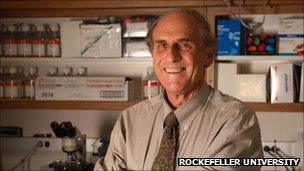Nobel winner Ralph Steinman's quest to cure cancer - including his own
- Published

Ralph Steinman died days before it was announced that he was to share the Nobel Prize for Medicine. His work had been part of an unorthodox experiment to save his life, writes journalist Brett Norman.
When Ralph Steinman learned he had pancreatic cancer, the dogged immunologist put his life's work to the test.
He launched a life-and-death experiment in the most personal of personalised medicine.
By unlucky coincidence, he had been diagnosed with a disease that might benefit from the therapies he had spent his life researching.
Usually, medical research proceeds at a glacial, thorough pace: cell studies lead to studies in small animals which lead to studies in larger animals, which eventually lead to small, highly-selective clinical trials in humans. But Steinman didn't have that kind of time.
He did, however, have access to world class facilities, cutting-edge technology, and some of the world's most brilliant medical minds, thanks to his position as a researcher at Rockefeller University.
So Steinman decided to make his own body the ultimate experiment.
He had removed a piece of the tumour that would eventually kill him. He then trained his immune cells to track down any hint of the tumour that might have escaped the surgery, like putting hounds on a scent.
On Friday, four-and-a-half years after he was diagnosed with a disease that kills the vast majority of its victims in less than one, that experiment came to an end.
Steinman died at the end of a week in which he continued his work in the lab. It was a testament to the undying optimism of the scientific enterprise, to the unrelenting man, and to the limits of both.
An open secret
I joined Rockefeller as a science writer to chronicle the work of its researchers - Steinman included - about halfway through one of his experiments on himself.
His experiment was an open secret on campus, registered with the hospital and aided by a long-time friend and staff physician. The sense of hope was palpable, bound up in respect for the man but also something broader.
Could the painstakingly incremental research that seemed to have so much potential on lab animals this once grant a reprieve from certain death?
Of course everyone was rooting for him, and I had a special interest. Toward the end of 1999, my father had a stomach complaint. Over a few months, the initial diagnosis of an ulcer morphed into a death sentence: inoperable, metastatic cancer of the pancreas.
Pancreatic cancer is often known as the "silent killer" because it usually doesn't produce truly scary symptoms until it has spread beyond repair. After chemotherapy, my dad bounced back for a few months, but the cancer inevitably did, too. He died at home in the early fall of 2000.
Could Steinman beat it?
I hoped so. The work had promise.
'Sceptical' science
In 1973, along with his mentor, Zanvil Cohn, Steinman published the discovery of a new class of cell in the immune system - the dendritic cell. Like many new discoveries, his faced a deeply sceptical reception.
The experiments couldn't be immediately reproduced, but Steinman was convinced of his discovery. He fought for a decade before immunologists began to broadly recognise the central importance of those cells to their field.
In the past 20 years, the study of dendritic cells has spread to hundreds of labs all over the world. Researchers are exploring how they might be harnessed to fight cancer, HIV and transplant rejection, among other major medical problems.
Dendritic cells are the "sentinel cells" of the mammalian immune system. Named after the Greek word for tree, they develop distinctive probing branches when activated, sweeping their environment in search of unwelcome things - like bacteria, viruses, tumours.
When dendritic cells encounter something they don't like, they take a physical marker of the invader, called an antigen, and present it to B and T cells, the defenders of the body' s immune system. Those cells then adapt weapons to identify and destroy the interlopers.
Steinman bet that if he could train his dendritic cells to recognise and tag his cancer, they would be able to convince the T and B cells to do the rest.
Dream deferred
There was no good reason to expect that Steinman could fashion a cure for one of the world's most vicious cancers in time to save his own life. But it was easy to think it was at least possible. The made-for-Hollywood story of the renegade scientist who fights the establishment to prove his discovery, and then uses it to cure himself, was powerful enough to compel hope.
Unfortunately, the dendritic cell-based treatments didn't work - at least not well enough.
Training Steinman's dendritic cells to the tumour did generate a "vigorous immune response to mesothelin, a tumour specific antigen," said Dr. Sarah Schlesigner, a longtime colleague of Steinman's who ran the trial.
In other words, while there were significant side effects, the therapy seemed to enable him to work much longer than he otherwise would have. Month after month, he remained at the University, continuing his work.
He survived much longer than expected, and continued his research until the end.
Over time, it wasn't enough.
At least, not enough to save him.
But the research he pioneered continues - and the scientists who continue his work have an extraordinary example to follow.
Brett Norman is a health care reporter for POLITICO Pro